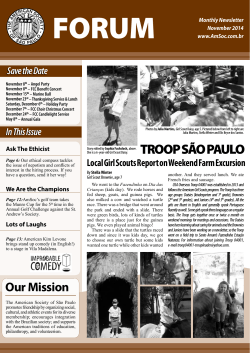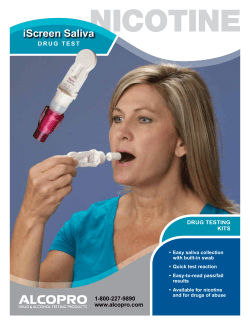
Proceedings of the 34th World Small Animal Veterinary Congress WSAVA 2009
Close this window to return to IVIS www.ivis.org Proceedings of the 34th World Small Animal Veterinary Congress WSAVA 2009 São Paulo, Brazil - 2009 Next WSAVA Congress : Reprinted in IVIS with the permission of the Congress Organizers Reprinted in IVIS with the permission of WSAVA Close this window to return to IVIS Abstracts - poster presentation CHRONIC ULCERATIVE LYMPHOPLASMACYTIC STOMATITIS IN A DOG - 594 Souza, FV 1; Werner, J 2; Pachaly, JR 3. 1. Clínica Veterinária S.O.S. Animais, Florianópolis, SC; 2. Laboratório Werner & Werner, Curitiba, PR; 3. Universidade Paranaense, Umuarama, PR. E-mail: sos.animais@hotmail.com Stomatitis in dogs is commonly associated with severe periodontal disease, renal failure, trauma, immune-mediated diseases, infection secondary to immunosuppression (diabetes mellitus, hyperadrenocorticism), and ingestion of caustic substances. Similar to cats with lymphocytic¬plasmacytic gingivitis stomatitis, dogs present an inflammatory condition in the oral cavity called ulcerative stomatitis, idiopathic stomatitis, or lymphocytic-plasmacytic stomatitis. An 8-year-old male Cocker Spaniel dog was presented for clinical examination with oral pain, dysphagia, severe halitosis, and diffuse hyperemia of the gum. The striking lesion was multiple ulcers on the gingiva of the caudal teeth where the buccal mucosa at the commissures contacted the tooth, and opposite the upper incisive teeth (also known as “kissing ulcers”) with adjacent gingival recession and dehiscence, and accumulation of partially chewed food at these sites. The superior incisive teeth were mobile. An initial treatment with clorhexidine, associated with antibiotic therapy with spiramycin plus metronidazole, and meloxicam for 10 days was recommended. The dog was then reevaluated and showed good recovering. However, 56 days later, the dog was brought again to the clinic and chief complaints were head pain when touched by the owner, and swelling of the upper lip. At that time, the same clinical features observed at the first physical examination were present. Radiographs revealed alveolar bone absorption around superior incisive teeth. Incisional biopsies were taken from the affected gingiva. Histologically, the lesion was characterized by severe interstitial lymphoplasmacytic infiltrate in the superficial corium of the gingiva. The epithelium was multifocally ulcerated and covered with variable layers of fibrin and neutrophils. In the remaining epithelium, areas of hydropic degeneration with mild hyperplasia were seen. Since auto-immune diseases were ruled out based on histopathological changes, a diagnosis of lymphoplasmacytic stomatitis, similar to those seen in cats was established, and the same treatment was performed. After 21 days of treatment with clindamycin and prednisone, there was partial resolution of the clinical signs. Since then, recurrent clinical signs appear when conservative treatment is interrupted. Repeated intermittent treatment has been performed to control the severity of the clinical signs. As in feline stomatitis, the underlying pathogenesis is unclear. It is suggested that this condition is an inflammatory rather than infectious process. If the conservative management with medications and home care are no longer effective, often selective teeth extractions are recommended. CASE REPORT: PHARYNGEAL MUCOCELE - 835 Kowalesky, J. 1 , Oshiro, A.H 1., Lagoa, A.C 2, Gioso, M.A .1 1. Universidade de São Paulo, São Paulo, Brazil; 2 Hospital Veterinário Rebouças, São Paulo, Brazil An eight years female mongrel dog was presented to the Veterinary Teaching Hospital of the University of São Paulo, “snoring” when eating and sleeping, had medical history of cervical mucocele treated only with medication three years before. The animal was radiographed and it was noticed a soft tissue structure in the pharyngeal area. The dog was sedated for evaluation. There was a floating collection in pharyngeal region that was aspirated; laboratory results from this fluid showed that it was saliva. Surgical procedure (marsupialization) was performed. After 2 months the dogs was sedated again and there was a total remission of the mucocele. The main functions of salivary glands are to lubricate food materials for swallowing and to keep the oral mucosa surfaces bathed with a fluid rich in antibacterial barriers. In carnivore animals, due to the rapid passage of the food through the mouth, there is a need for a large volume of lubricating fluid for a short time and for continuous secretion at a basal level at other times. Major salivary glands in carnivores are the mandibular, parotid, sublingual and zygomatic. There are many others areas of salivary glands tissue scattered throughout the mouth, particularly in the lips and the glossopalatine arch area. Clinical disease associated with salivary glands results from several processes. The conditions that generally affect the salivary glands are: overproduction, immune-mediated disease, compartment syndrome, sialolith, neoplasias and mucoceles. Mucoceles occur due to extravasation of saliva from a duct, forming a collection of saliva and mucous tissue in the subcutaneous space. Saliva takes the path of least resistance; the most common sites for collection of the extravased saliva are the subcutaneous tissues of the intermandibular or cranial cervical area, the sublingual tissues and less common in the pharyngeal wall. The mucoceles are generally seen as protuberances painless and floating. It is unusual a spontaneous regression of the process. A pharyngeal mucocele can obstruct the pharyngeal airway; emergency lancing may be necessary occasionally to relieve respiratory distress. Diagnosis is by aspiration of goldencolored or blood-stained mucus from swelling. Staining a smear of the fluid with a mucus specific stain, such as PAS confirms the diagnosis. Periodic drainage is not recommended for pharyngeal mucoceles. Abstracts expanded - poster presentation MICROBIOLOGICAL ANALYSIS OF PERIODONTAL DISEASE BACTERIAL PLAQUE ON DOGS AND EFFECTS OF ANTIBIOTICOTHERAPY ON IT - 480 Fonseca S. A., Diniz P. D., Perecmanis S., Silva A. S., Cardozo, L. B., Marçola T. G. & Drummond V. O. Universidade de Brasília, Campus Universitário Darcy Ribeiro, Brasília-DF, CEP: 70.910-900. E-mail: contato@stellaalves.com Introduction Periodontal disease (PD) affects the tooth support tissue and the periodont and it is the main cause of tooth loss in small animals (Williams 1997). Bacterial plaque is responsible for most oral affections (Gioso & Correa 2003, Meira et al. 2007), which prevalence increases with age, 34 reaching about 80% of dogs over five years old (Harvey & Emilly 1993, Marreta 2001). Treatment of PD and odontogenic diseases is based on removal of sub and supragingival bacterial plaque, polishing of dental crowns and correct antibioticotherapy (Nelson & Couto 2001, Salinas et al. 2006). Effective antibiotics against anaerobic bacteria, like clin- Clínica Veterinária, Ano XIV, suplemento, 2009 34th World Small Animal Veterinary Congress 2009 - São Paulo, Brazil
© Copyright 2025





















